|
USPSNEWS@WORK
New Inspector General: David Williams
named second USPS IG
The governors of the United States Postal Service®
named David Williams to be the second USPS® inspector
general. Williams has served as the inspector general at
four different federal agencies: Internal Revenue Service,
Department of Treasury, Social Security Administration,
and Nuclear Regulatory Commission.
He has testified before Congress on more than 40 occasions. "As demonstrated by four different presidential appointments and his service on the President's Council on
Integrity and Efficiency, he is well known and highly regarded by the Congress and the inspector general community," the governors said.
Deadline extended: Corporate
Succession Planning is open until Sept. 12
Whew-w-w! Eligible employees can breathe a sigh of relief. They have until Sept. 12 - instead of Sept. 5 - to fill
out their applications for Corporate Succession Planning.
Eligible employees are current PCES executives or EAS
employees at EAS-22 level or above who have demonstrated successful performance through merit evaluations
over the last two years.
Don't wait until the last minute. If you meet the eligibility
requirements, you can apply today at the Diversity Development Web Site. Go to http://blue.usps.gov/diversitynet;
and then click on the Corporate Succession Planning link.
Customer Feedback: It helps us keep
improving
Customer complaints - no one likes them, but if you
think of them as another opportunity to get it right, they become valuable business information.
Notice 4314-C, We Want to Know, gives customers
three options for voicing their concerns - speaking to the
postmaster/manager, visiting usps.com or calling 800-ASK-
USPS (275-8777) - and should be placed in all retail lobbies for easy customer access.
Research indicates many customers don't complain -
they just switch their business to another company. We
Want to Know will help keep our customers coming back.
Catching up with catch-ups: Pay period
deduction and total contribution -
Know the difference
It's a hit. Thousands of employees have signed up to
make Thrift Savings Plan (TSP) 50+ catch-up contributions
using PostalEASE. If you're age 50 and older, you can sock
away an extra $2,000 in your TSP account.
Remember, the amount you choose is a pay period deduction - not the total contribution for the year. For example, if you elected a $1,000 contribution, then $1,000 will be
deducted from your next paycheck and another $1,000
from the following paycheck. You'll reach the $2,000 IRS
maximum in just two paychecks.
Important: If there isn't enough money available in your
paycheck to cover the full $1,000, then there won't be any
contribution taken from your paycheck.
Eligible employees can use PostalEASE to begin,
change or cancel TSP 50+ catch-up contributions at any
time.
Strategic Planning: PMG announces
new VP
PMG Jack Potter announced the selection of Linda
Kingsley as the new vice president of Strategic Planning.
In her new role, Kingsley will be responsible for coordinating the development of plans and analyses contributing
to the establishment of the strategic direction of the Postal
ServiceTM. Strategic Planning also manages and tracks implementation of the Transformation Plan.
Most recently, Kingsley served as manager of Activity-
Based Costing. That initiative supports the Transformation
Plan by identifying all costs related to mail-processing activities - and the source of those costs - so that the Postal Service can pursue additional cost-reduction efforts.
Kingsley began her 18-year Postal Service career as an
industrial engineer trainee in the former Central Region.
She has extensive knowledge of the rate-setting process
and testified before the Postal Rate Commission in three
rate cases, both as a member of the rates organization and
as an operations expert.
USPSNEWS@WORK
FY 2004 begins Oct. 1: Project EaGLe
has landed
Financially speaking, monthly reporting begins Oct. 1.
The 28-day postal accounting period (AP) will soon be history. USPS will track and report its finances based on calendar months, just like the rest of the federal government
and most of the private sector.
The current postal fiscal year 2003 ends Sept. 5. The
period from Sept. 6 through Sept. 30 will be a transition
period.
Need more information? Visit http://blue.usps.gov/finance/monthrpt/monthrpt.htm.
As the Postal Service converts its financial reporting
system from APs to monthly reporting periods, the general
ledger system - the core of USPS financial reporting - is
being replaced to enable the changeover.
This effort is called Project eaGLe - "Excellence in
Accounting through the general ledger." Finance and
Information Technology are working to create a state-of-
the-art system that will house reconciled accounting information in a single source - the accounting data mart
(ADM). ADM will be part of the enterprise data warehouse,
an organization-wide data mine.
The project is currently on schedule to be implemented
Oct. 1, when monthly reporting starts. The new general ledger system will provide more consistent and up-to-date
financial information, and improve the way you access
financial data.
Go to the Project eaGLe Web site at
http://blue.usps.gov/finance/gl/gl.htm for more information.
2003 National Awards for Diversity
Achievement: Hurry, nomination period
closes Sept. 12
Diversity achieved is an honor shared. The Postal Service is still seeking nominations for the 2003 National
Awards Program for Diversity Achievement.
• Do you know someone on the Postal Service team
who encourages, promotes and celebrates diversity,
and deserves to be honored for those efforts? Make
sure that person gets the recognition he or she
deserves!
• Nominations are being accepted through Sept. 12 for
the 2003 National Awards Program for Diversity
Achievement. All employees are eligible for this prestigious program. This honor is the largest peer recognition program at the Postal Service. It demonstrates
the promise and strength of our organization and the
importance of sharing values and building unity.
• For more information about the awards, or to make a
nomination, visit the Diversity Development Web site
at http://blue.usps.gov/diversitynet.
Get Flexible: FSA open season coming
soon
There's more to back to school than buying a new pack
of No. 2 pencils for the kids. It's also a time to get medical
checkups, immunizations, eye exams, and maybe even
braces. That's when a Flexible Spending Account (FSA)
can come in mighty handy.
An FSA lets you put some money aside every year to
help you with co-pays and other out-of-pocket health care
expenses. And the money you've put aside is tax-exempt!
So put a smile on your child's face - and yours - with an
FSA.
If you don't currently have an FSA, mark your calendar.
Open season is coming Nov. 10. You'll be getting details in
the mail before open season starts.
The Postal Bulletin - Help Us Save Paper and Money
The Postal Bulletin has been around for 123 years, and
it's the most relied-upon, trusted source of information in
the Postal ServiceTM today.
In the 1970s, when our nation became more concerned
about our environment, the Postal Service began using recycled paper to print the Postal Bulletin. We have also tried
over the years to print just the right number of copies to
save our nation's resources.
Despite our efforts, some offices tell us that they receive
too many copies. We need to do something about this.
Therefore, if you want to reduce the number of copies
your office receives or if you want to cancel your
subscription altogether, send an e-mail to
pbulleti@usps.gov or call 202-268-5776 (if you reach a
recording, be sure to leave a message with your name,
telephone number, and ZIP Code). Please be assured that
we will not reduce or cancel your subscription unless you
ask us to do so.
As we review our subscription list, we will begin calling
facilities that seem to have duplicate subscriptions. If we
call your facility, please help us determine if we can reduce
your subscription.
Are you using your own labels to forward Postal Bulletins to other facilities that don't have their own subscriptions? When those other facilities close down, the
undeliverable Postal Bulletins are returned to us here at
Headquarters. When we receive those returned Postal Bulletins, we have no way of correcting the problem, because
those facilities aren't on our subscription list and because
we don't know which is the forwarding facility.
If you are forwarding Postal Bulletins to other facilities,
please contact us at the above e-mail address or phone
number so we can create a separate subscription for them.
Remember, each issue of the Postal Bulletin since 1995
is available online. To access the online version of the Postal Bulletin, please follow either of these routes:
• On the Intranet: Go to the Postal Service PolicyNet
Web site at http://blue.usps.gov/cpim; click on View
Postal Bulletins.
• On the Internet: Go to www.usps.com; click on
About USPS & News, then Forms and Publications,
then Postal Bulletin.
For more information on the Postal Bulletin, please
see our article in Postal Bulletin 22097 (3-6-03, pages
5-6) titled "The Postal Bulletin - Your Source for Trusted
Information."
We started publishing this article in early April, asking
you to let us know if we can reduce or eliminate your subscriptions. Since April of this year, many of you have
responded, and together we have reduced the total number
of printed copies by 7,475!
We've come a long way, and we'll continue to evolve
with the times. Our job is to make your job easier. As you
know, the Postal Bulletin is here to serve you, as it has
been for almost 125 years.
- Policies and Procedures Information,
Public Affairs and Communications, 9-4-03
NEW HANDBOOK AS-353/ASM REVISION
The new Handbook AS-353, Guide to Privacy and the
Freedom of Information Act, soon will be available and becomes effective September 30, 2003. This handbook provides direction and guidance for Postal ServiceTM
employees, suppliers, or other authorized users with access to Postal Service records and information resources.
The handbook explains record management requirements
for information relating to the Postal Service, its customers,
and its employees, and also details how information is collected, maintained, used, disclosed, and safeguarded.
Issuance of this handbook represents the Postal Service's continuing efforts to protect business and personal
information. A vital element to the Transformation Plan is
achieving growth by adding value for customers, and protecting their information is key to our trusted brand. Information is often confidential or proprietary, and its
inappropriate use or disclosure could result in brand or financial damage, unfair advantage to competitors, or negative impact to our customers or employees.
This handbook also updates and streamlines Freedom
of Information Act (FOIA) policies and procedures and increases FOIA fees to reflect current allowable costs.
We are sending copies of Handbook AS-353 to all
appropriate Headquarters, area, district, and local Post
OfficeTM employees. The handbook will soon be available
at:
• The Postal Service PolicyNet Web site, on the
Intranet.
• The Internet.
• The Material Distribution Center (MDC).
We will announce the availability of Handbook AS-353 at
the MDC, along with information about ordering it, in a
future issue of the Postal Bulletin.
As a result of the publication of Handbook AS-353 (and
also of MI AS-350-2003-5, Computer Matching Programs),
portions of the Administrative Support Manual (ASM) are
revised. We will incorporate these revisions into the printed
version of ASM 14 and into the online version of the ASM,
which is accessible on the Postal Service PolicyNet Web
site at http://blue.usps.gov; click on More References, then
Manuals.
Administrative Support Manual (ASM)
* * * * *
3 Communications
* * * * *
35 Records and Release of Information
[Revise text of subchapter 35 to read as follows. Current
Exhibits 351.21 and 351.513 are unchanged but recodified
as new Exhibits 351.11 and 351.313, respectively. The exhibits are not shown in this article.]
351 Records
351.1 Retention
351.11 Records Control Schedules
The most widely held Postal Service records series are
listed in Handbook AS-305, Records Control. See also
Exhibit 351.11 (located at the end of 35) for the retention
periods for most forms used at Post Offices. Keep records
for the periods shown in Handbook AS-305 or Exhibit
351.11 and then dispose of them as specified in 351.4.
351.12 Other Records
For information about the retention of records not covered
by Handbook AS-305 or Exhibit 351.11, contact the manager of the Records Office at 202-268-2608.
351.13 Extension of Retention Periods
The retention periods published in Handbook AS-305, Records Control, and Exhibit 351.11 are mandatory. Records
must not be maintained for periods longer than those specified in these schedules. However, retention periods may be
extended in response to a court order, or if the records are
needed for a special use. Only the Postal Service Records
Office may authorize these extensions. On expiration of
such an extension of retention period, that office notifies
concerned custodians to observe normal records retention
requirements.
351.2 Information Caveats
A caveat is a phrase typed or stamped on a record (usually
at the top or bottom) indicating that the information in the
record must be protected or handled in a special way. Officials who wish to use a Restricted Information caveat but
are unsure about the proper application may request guidance from the manager of the Records Office. When
placing caveats on information or records, use the following
guidelines:
a. Restricted Information. The term Restricted Information may be used to indicate records or information
that is restricted based on Postal Service regulations
(see Handbook AS-353, Guide to Privacy and the
Freedom of Information Act). Included is information
about individuals, certain types of business information, and other information such as customer mailing
lists. This information has limitations placed on its access within the Postal Service and its disclosure outside the Postal Service.
b. National Security Information. The terms CONFIDENTIAL, SECRET, and TOP SECRET (also referred to as Classified Information) are used only to
refer to national security information under Executive
Order 12356. Only designated senior officials may
apply these caveats.
c. Other Caveats. Limited Official Use, For Confidential
Use Only, and other similar terms are inappropriate
for use at any time within the Postal Service.
351.3 Transfer
351.31 Storage
351.311 Requirement
Records no longer required for active reference but not yet
eligible for destruction must be transferred by the cutoff period (e.g., period of time such as a quarter or fiscal year) to
local storage or a Federal Records Center (FRC).
351.312 Local Storage
Transfer to local Postal Service storage must be accompanied by PS Form 773, Records Transmittal and Receipt.
351.313 Federal Records Centers
The following apply:
a. Conditions. Forward to FRCs only:
(1) Records series approved by the National Archives and Records Administration (NARA) and
having a remaining life of more than 1 year.
(2) Volumes of records consisting of 1 cubic foot or
more. (Quantities less than 1 cubic foot must be
kept by the installation and destroyed in-house
when the retention period expires.)
b. Procedures. Procedures for sending employee personnel and medical records to the National Personnel Records Center (NPRC) are provided in
Handbook EL-301 section 131.5 and Postal Bulletin
21803 (11-28-91, page 6). For shipment to an
FRC other than the National Personnel Records
Center at St. Louis, Missouri:
(1) Assemble records to be shipped and pack (to
capacity) in 1 cubic foot boxes, obtained for this
purpose from the General Services Administration. Prepare a box list, identifying the folders in
each box, in duplicate. Insert one copy of the box
list in the first box of the accession, to be shipped
with the records, and retain one copy locally.
(2) Complete two copies of SF 135, Records Transmittal and Receipt. This form may be ordered
from the Material Distribution Center (MDC).
Send both copies to the receiving FRC at least 2
weeks before the intended shipping date.
(3) The FRC shows approval by returning one annotated copy of SF 135 to the requesting installation.
(4) Place a copy of SF 135 in the first box of the
shipment and ship. Hold a copy as suspense.
(5) The FRC then returns a receipted copy of SF
135.
c. Location. See Exhibit 351.313 for FRC addresses
and areas served.
d. Retrieval. Retrieval of all records is handled by the
installation from which the records were sent. Requests for retrievals are made on Optional Form (OF)
11, Reference Request - Federal Records Centers.
FEDSTRIP ordering offices order this form directly
from GSA; non-FEDSTRIP ordering offices order this
form from their supporting supply section, or from
their GSA Customer Supply Center. Retrievals are
made at the FRCs by the accession number and the
box location number recorded on the SF 135 when
the records were approved for transfer.
351.32 Control
Records transferred to local or FRC storage remain under
Postal Service control.
351.4 Disposal
351.41 Definition
Disposal is
the permanent removal of records or information from Postal Service custody
using any of these
methods:
a. Transferring to the National Archives.
b. Donating to the Smithsonian Institution, local museums, or historical societies.
c. Selling as waste material (see 351.42).
d. Discarding.
e. Physically destroying.
351.42 Sale
Paper records whose retention periods have expired may
be sold as waste paper, if they do not include information
that cannot be disclosed to the general public, such as personal information. (Those records must be destroyed.) The
contract for sale must prohibit the resale of the records as
records or documents. Film or plastic records may be sold
under the same conditions and in the same manner.
351.43 Destruction
Records that cannot be sold may be destroyed by shredding, pulping, or burning.
352 Micrographics
352.1 Definitions
352.11 Micrographics
Micrographics is a technology that reduces any form of information to a microform medium.
352.12 Microform
Microform is a generic term for any form, either film or paper, that contains microimages; a unit of information, such
as a page of text or drawing, too small to be read without
magnification.
352.2 Policy
Micrographics may be used for the following purposes, if
the applications are supported by enough documentation to
prove cost-effectiveness and provide maximum compatibility with other micrographic applications, systems, and
equipment:
a. Preservation of deteriorating records.
b. Production of archival or intermediate records.
c. Duplication of information for dissemination to other
locations.
d. Increased efficiency in searching records.
e. Greater security for sensitive records.
f. Reduction of paper record holdings or use of space.
352.3 Requirements
352.31 Legal
Federal statutes provide for the legality
and admissibility of
microforms that accurately reproduce or form a durable
medium for reproducing the original record (28 U.S.C.
1732). To meet the requirements of these statutes, microform records must be
produced in the regular course of business and be able to be satisfactorily identified and certified (e.g., by Form 6550, Declaration of Intent, and Certification of Authenticity).
a. Retention of original documents may sometimes
be necessary to resolve questions of document
authenticity.
b. If authenticity of documents having legal significance
could be subject to question, obtain the advice of the
chief field counsel (or for Headquarters organizations, the managing counsel, civil practice) before
disposing the original.
352.32 Archival
Only original silver halide microfilm has sufficient archival
quality to be substituted for documents requiring permanent retention or to produce microforms of permanent
retention value.
352.33 Maintenance and Disposal
Microforms are subject to all regulations on retention, disclosure, privacy, and security of Postal Service records and
information.
353 Automated Information Processing Security
353.1 General
353.11 Definition
Information protection is the securing of information against
unauthorized modification, destruction, or disclosure (intentional or accidental) from collection throughout its intended
useful life.
353.12 Scope
This policy covers protection of automated information and
related resources at all Postal Service facilities. It encompasses protection of information maintained on any equipment or system with automated information processing,
storage and/or retrieval capabilities, as well as the related
resources that allow processing, storage, and retrieval of
the information. These automated systems/equipment can
be referred to as any of the following: personal computers
(PCs); data processing equipment; minicomputers; microcomputers; microprocessors; office automation systems;
stand-alone, shared-logic, or shared-resource systems;
process control systems. Related resources include hardware (central processing units (CPUs), terminals, modems,
printers, etc.), software (programs and associated documentation), and media (magnetic tapes, disks, diskettes,
etc.).
355.13 Information Life Cycle
Information must be protected during the information life
cycle. This includes information creation/collection, information processing, information use, information maintenance, and information disposal.
353.2 Policy
It is Postal Service policy to protect its automated information systems from the hazards described below consistent
with the value of the information:
a. Theft, fraud, or other abuse of information, equipment, or funds.
b. Unauthorized access to or disclosure of information.
c. Accidental or unauthorized destruction or modification of information.
d. Interruption of information processing capability due
to equipment malfunction/damage, facility damage,
power outage, etc.
353.3 Responsibility
353.31 Specific
353.311 Management
Management at all levels must recognize the need for
information protection and enforce security policies and
procedures.
353.312 Installation Heads and Vice Presidents
As records custodians, installation heads and vice presidents are accountable for information, equipment, and systems within their custody including:
a. Making staff aware of the need for security and developing necessary guidelines and procedures for
staff to follow.
b. Determining whether the level of security provided
for a system is appropriate for the value of the
information.
c. Ensuring that Postal Service security policy, guidelines, and procedures are followed in all system activities, including procurement, development, and
operation.
d. Providing the resources to enable employees to carry
out their responsibilities for securing information and
related resources.
e. Assigning overall information protection responsibility to a specific individual (e.g., a computer systems
security officer).
353.313 Users
Individual users of information processing equipment are
responsible for:
a. Following permissible uses of systems, equipment,
and information as well as the information disclosure
prohibitions under the Postal Service Rules of Conduct (see ELM 668.3).
b. Protecting systems, equipment, and information assigned to them or in their custody and use.
c. Using the equipment only for activities approved by
management.
d. Protecting any user IDs and passwords assigned to
them.
e. Notifying management of any security violations of
which they are aware.
353.32 Advisory
Security assistance to vice presidents, installation heads,
and other managers is available from:
a. Corporate Information Security Office (CISO).The
CISO can provide guidance on technical (hardware,
software) issues, risk analysis, and contingency
planning.
b. Postal Inspection Service. The local postal inspector
can provide assistance on physical and personnel
security. Consult the deputy chief auditor at Headquarters about audit trails.
c. Records Office. The Records Office can assist with
information evaluation and retention issues. Contact
the Records Office at 202-268-2608.
d. Purchasing. Supply Management at Headquarters
and purchasing organizations in the field can help
with purchase requests for security hardware, software, or services. They can also conduct market surveys of security features available commercially.
353.4 FLSA Considerations (Reserved)
353.5 Information Evaluation
353.51 General
All information maintained on information processing equipment requires some protection. Sensitive information requires a greater degree of protection. Installation heads
must evaluate the information they intend to maintain on information processing equipment for its sensitivity and develop security measures consistent with its sensitivity.
353.52 Sensitive Information
Sensitive information is information identified by the Postal
Service as "restricted" or "critical." Restricted information
has limitations on its internal or external disclosure. Critical
information is information that must be available for the
Postal Service to perform its mission and meet legally assigned responsibilities, and for which special precautions
are taken to ensure its accuracy, relevance, timeliness, and
completeness. (This information, if unavailable, can cause
significant financial loss, inconvenience, or delay in performance of the Postal Service mission.)
353.6 Security Considerations
The type and degree of security needed varies by the value
and sensitivity of the information, the type of equipment
used, and the size and general nature of an installation.
Installation heads must evaluate their individual situations
to determine the degree of security that is practicable without being cost prohibitive. The following issues must be
considered when determining security needs:
a. Procurement.
b. Risk analysis.
c. Physical security.
d. Personnel security.
e. Hardware operations.
f. Software.
g. Audit trails.
h. Contingency planning.
i. Training.
353.7 Information Retention
Information must be retained as follows:
a. Retention of information in automated information
processing systems must be consistent with official
Postal Service records retention schedules.
b. Procedures must be established for routine purging/disposition of information maintained on diskettes
and other storage media.
c. Retention of information on information processing
equipment must be according to Preservation Orders
(e.g., as a result of FLSA litigation).
* * * * *
[Delete Appendix - Privacy Act Systems of Records.]
* * * * *
- Privacy Office,
Consumer Advocate, 9-4-03
The mailings below will be deposited in the near future.
Offices should honor the requested delivery dates.
Mailers wishing to participate in these alerts, for mailings of
1 million pieces or more, should contact Business Service
Network Integration at 703-292-4041 at least 1 month preceding the requested delivery dates. The Postal ServiceTM
also offers electronic Mail Alerts via ADVANCE. For more
information, see the ADVANCE Notification & Tracking
System Technical Guide on the Internet at
http://www.ribbs.usps.gov/files/advance/ADVTECH.PDF or
contact the National Customer Support Center at
800-458-3181.
|
Title of Mailing
|
Class and
Type of
Mail
|
Requested
Delivery
Dates
|
Number
of Pieces
(Millions)
|
Distribution
|
Presort Level
|
Comments
|
|
JCP Week 33 Salon Color
Treatment
|
Standard/Postcard
|
9/3/03-9/5/03
|
1.5
|
Nationwide
|
Car-Rt
|
Harte-Hanks
|
|
JCP Sale Multidivisional
|
Standard/Catalog
|
9/5/03-9/9/03
|
4.6
|
Nationwide
|
Car-Rt
|
Quebecorworld
|
|
JCP Week 33 Fall Sale Preview
|
Standard/Flat
|
9/6/03-9/9/03
|
20.4
|
Nationwide
|
Car-Rt
|
Harte-Hanks
|
|
Seventh Avenue
|
Standard
|
9/8/03-9/11/03
|
1.0
|
Nationwide
|
Barcoded, Basic,
3/5-Digit, Car-Rt
|
Quad Graphics,
Lomira, WI
|
|
Through the Country Door
|
Standard
|
9/8/03-9/11/03
|
1.0
|
Nationwide
|
Barcoded, Basic,
3/5-Digit, Car-Rt
|
Quad Graphics,
Lomira, WI
|
|
JCP Week 34 Fall Jewelry/Scratch
Off
|
Standard/Flat or
Letter
|
9/13/03-9/16/03
|
6.3
|
Nationwide
|
Car-Rt
|
Harte-Hanks
|
|
JCP Week 34 Privilege Gold
|
Standard/Letter
|
9/13/03-9/16/03
|
3.8
|
Nationwide
|
Car-Rt
|
Harte-Hanks
|
|
JCP Fall Preview Cat PC
|
Standard/Postcard
|
9/15/03-9/17/03
|
5.0
|
Nationwide
|
Car-Rt
|
Harte-Hanks
|
|
Seventh Avenue
|
Standard
|
9/15/03-9/18/03
|
2.6
|
Nationwide
|
Barcoded, Basic,
3/5-Digit, Car-Rt
|
Quad Graphics,
Lomira, WI
|
- Business Service Network Integration,
Service and Market Development, 9-4-03
|
DMM REVISION
Effective September 4, 2003, Domestic Mail Manual
(DMM) D210.2.0, D210.4.1, and D210.4.4 are revised and
new D210.4.5 is added to incorporate the existing procedures for depositing Periodicals items at the airport mail
centers/facilities (AMCs/AMFs) by freight forwarders. This
option is available for only Periodicals mail.
With the Periodicals industry, the Postal ServiceTM has
developed enhancements to the process for entering Periodicals items at AMCs/AMFs that are responsive to our
customers' needs, retain accountability, and are standardized. Network Operations Management has developed a
standard operating procedure (SOP) to standardize acceptance procedures at AMCs/AMFs (available through each
AMC/AMF manager).
Freight forwarders and cargo agents have unique requirements imposed by airlines when delivering Periodicals
items by air to AMCs/AMFs. Regular meetings are held
among the Periodicals industry, publishers, commercial
airfreight forwarders, and the Postal Service to improve
Periodicals entry procedures. The national SOP uses established plant-verified drop shipment (PVDS) procedures.
When normal procedures are insufficient, all parties can
develop and agree on customized local solutions and operational agreements.
We will incorporate these revisions into the printed
version of DMM Issue 59 and into the monthly update
of the online DMM available via Postal Explorer at
http://pe.usps.gov.
Domestic Mail Manual (DMM)
* * * * *
D Deposit, Collection, and Delivery
* * * * *
D200 Periodicals
D210 Basic Information
* * * * *
2.0 MAIL DEPOSIT
***The publisher or news agent must present mailings at
the Periodicals rates only:
* * * * *
[Revise item b to clarify that Periodicals must be deposited
at times and places designated by the postmaster or AMC/AMF manager:]
b. At times and places designated by the postmaster of
the office of mailing or by the AMC/AMF manager.
* * * * *
4.0 DEPOSIT AT AMF
4.1 General
[Revise 4.1 to clarify that Periodicals deposited at an AMC/AMF must be entered under the plant-verified drop shipment program:]
Periodicals publications air freighted to an AMC/AMF must
have either an original or additional entry authorization at
the verifying office (i.e., the Post Office where those copies
are presented for Postal Service verification) and must be
presented to an AMC/AMF under the PVDS program. Postage must be paid at the verifying office unless the publication is authorized under the Centralized Postage Payment
program.
* * * * *
4.4 Publisher Responsibilities.
For each mailing to be presented at the AMF, the publisher
or agent is required:
* * * * *
[Revise item b to specify delivery area as required by the
AMC/AMF manager to read as follows:]
b. To arrange for delivery of the airfreighted copies of
the publication to the AMC/AMF "back dock" or other
area designated by the AMC/AMF manager.
* * * * *
[Add items e through g to read as follows:]
e. To ensure that Form 8125 accompanies each shipment. The total number of airline cargo containers
must be annotated on the form in the comment section. Each airline cargo container must be sequentially numbered (e.g., 1 of 4, 2 of 4, etc.), and a copy of
Form 8125 must be affixed to each airline cargo
container.
f. To provide a list, at least once a year, of publications
entered at the AMC/AMF and a 24-hour contact number to the AMC/AMF manager.
g. To follow procedures outlined in Network Operation
Management's standard operating procedures. The
procedures are available from the AMC/AMF
manager.
[Add new 4.5 for nonconforming mailers to read as follows:]
4.5 Nonconforming Mailers
Whenever a Periodicals mailing presented to an AMC/AMF
fails to meet the procedures outlined in Network Operation
Management's SOP or fails to meet either the basic mail
preparation standards or the PVDS entry integrity and safety standards, the Postal Service will inform the mailer, or
the mailer's agent, who presented the mailing. If, after the
initial notification, the mailer continues to fail to meet the
standards, the mailer is considered nonconforming. If a
mailer is found to be nonconforming, its authorization to
enter mail at an AMC/AMF may be revoked by the Postal
Service.
* * * * *
- Business Mail Acceptance,
Marketing Technology and Channel Management, 9-4-03
DMM REVISION
Effective September 4, 2003, Domestic Mail Manual
(DMM) C820.4.3 is revised to clarify polywrap standards for
the maximum amount of overhang (selvage) permitted for
automated flat sorting machine (AFSM) 100-compatible
flat-size pieces. Current mailing standards for polywrap, reorganized and published in Postal Bulletin 22106 (7-10-03,
pages 25-27), provide maximum limits on the amount of
polywrap overhang (selvage) beyond the size of the enclosed mailpiece.
The overhang standards for AFSM 100-compatible flat-
size pieces currently reflect the standards for the FSM 881,
which the Postal ServiceTM has discontinued using for processing flat-size pieces. The actual maximum selvage limits
for the AFSM 100 are the reverse of those used for the
FSM 881 and are amended as follows:
• Overhang at Top. When the contents of an AFSM
100-compatible mailpiece are positioned completely
at the bottom of the polywrap, the overhang must
be 1/2 inch (0.5 inch) or less above the top of the
mailpiece.
• Overhang on Side. When the contents of an AFSM
100-compatible mailpiece are positioned completely
to the left or to the right side of the polywrap, the
overhang must be 1-1/2 inches or less on the opposite side.
We will incorporate these revisions into the printed version of DMM 59 and into the monthly update of the online
DMM available via Postal Explorer at http://pe.usps.gov.
Domestic Mail Manual (DMM)
* * * * *
C Characteristics and Content
* * * * *
C800 Automation-Compatible and Machinable Mail
* * * * *
C820 Flats
* * * * *
4.0 POLYWRAP COVERINGS
* * * * *
4.3 Overhang
For purposes only of the polywrap standards for overhang
(selvage) in 4.0, the edge of the mailpiece designated as
top must be one of the two physically longer edges of
the piece, regardless of address orientation and whether
bound or unbound. Any polywrap overhang (selvage)
around the four edges of the mailpiece (top, bottom, and left
and right sides) must meet these standards:
a. For an AFSM 100 mailpiece:
[Change "1.5 inches" to "0.5 inch" in 4.3a(1) to read as
follows:]
(1) When the mailpiece contents are totally positioned at the bottom of the polywrap, the overhang must not be more than 0.5 inch at the top of
the mailpiece.
[Change "0.5 inch" to "1.5 inches" in 4.3a(2) to read as
follows:]
(2) When the mailpiece contents are totally positioned to the left or to the right side of the polywrap, the overhang must not be more than 1.5
inches on the opposite side.
* * * * *
- Mailing Standards,
Pricing and Classification, 9-4-03
DMM REVISION
Effective September 1, 2003, Domestic Mail Manual
(DMM) E110.1.3, E110.4.1, E140.1.1b, E610.1.2,
E610.2.1, E610.6.1, E610.8.0b, E640.1.1b, E670.8.1,
G043, and I022 are revised and G991 (formerly DMM
G091) is deleted to reflect the expiration of the experimental classification for NetPost Mailing OnlineTM. While the
Postal ServiceTM is no longer hosting Mailing Online for
entry of hybrid mail, and its exceptions to requirements for
volume minimums are no longer available to any hybrid
providers, all preexisting NetPostTM services can be accessed via links from USPS.com.
The Postal Service conducted the experiment pursuant
to the Decision of the Governors of the Postal Service on
the Opinion and Recommended Decision of the Postal
Rate Commission (PRC) in Docket No. MC2000-2. The
experiment was approved by the Governors to run for 3
years, with an implementation date of September 1, 2000
(Resolution No. 00-10).
We will incorporate these revisions into the printed version of DMM 59 and into the monthly update of the online
DMM available via Postal Explorer at http://pe.usps.gov.
Domestic Mail Manual (DMM)
* * * * *
E Eligibility
* * * * *
E100 First-Class Mail
E110 Basic Standards
1.0 CLASSIFICATION AND DESCRIPTION
* * * * *
1.3 Matter Closed Against Postal Inspection
[Revise 1.3 by deleting the second and third sentences.]
* * * * *
4.0 FEES
4.1 Presort Mailing
[Revise 4.1 by deleting the last sentence.]
* * * * *
E140 Automation Rates
1.0 BASIC STANDARDS
1.1 All Pieces
All pieces in a First-Class Mail® automation rate mailing
must:
* * * * *
[Revise 1.1b by deleting "or be part of a mailing using
NetPost Mailing Online service or a functionally equivalent
service under G991" to read as follows:]
b. Be part of a single mailing of at least 500 pieces of
automation rate First-Class Mail, subject to 1.2.
* * * * *
E600 Standard Mail
E610 Basic Standards
1.0 BASIC INFORMATION
* * * * *
1.2 Postal Inspection
[Revise 1.2 by deleting references to NetPost Mailing Online to read as follows:]
Standard Mail is not sealed against postal inspection. Regardless of physical closure, the mailing of articles at Standard Mail rates constitutes consent by the mailer to postal
inspection of the contents.
* * * * *
2.0 CONTENT
2.1 Circulars
[Revise the first sentence in 2.1 by deleting "or are provided
for entry using NetPost Mailing Online service or a functionally equivalent service (G991)" to read as follows:]
Circulars, including printed letters that, according to their
contents, are sent in identical terms to more than one person are Standard Mail.***
* * * * *
6.0 FEES
6.1 Annual Fees
[Revise 6.1 by deleting the last sentence.]
* * * * *
8.0 PREPARATION
Each Standard Mail mailing is subject to these general
standards:
* * * * *
[Revise the first sentence of 8.0b by deleting "or be provided for entry using NetPost Mailing Online service or a
functionally equivalent service under G991" to read as
follows:]
b. Each mailing must contain at least 200 pieces or 50
pounds of pieces.***
* * * * *
E640 Automation Rates
1.0 REGULAR AND NONPROFIT RATES
1.1 All Pieces
All pieces in a Regular Standard Mail or Nonprofit Standard
Mail automation rate mailing must:
* * * * *
[Revise 1.1b by deleting "or be provided for entry using
NetPost Mailing Online service or a functionally equivalent
service under G991" to read as follows:]
b. Be part of a single mailing of at least 200 pieces or 50
pounds of pieces of automation rate Standard Mail
(Regular and Nonprofit mailings must meet separate
minimum volumes).
* * * * *
E670 Nonprofit Standard Mail
* * * * *
8.0 AUTHORIZATION-AT ADDITIONAL OFFICES
8.1 Application
[Revise 8.1 by deleting last sentence.]
* * * * *
G General Information
G000 The USPS and Mailing Standards
* * * * *
G040 Information Resources
* * * * *
G043 Address List for Correspondence
[Delete address entry for "NETPOST MAILING ONLINE."]
* * * * *
G900 Experimental Classification and Rate Filings
* * * * *
G990 Experimental Classifications and Rates
* * * * *
[Delete G991, NetPost Mailing Online.]
* * * * *
I Index Information
I000 Information
* * * * *
I020 References
* * * * *
I022 Subject Index
[Delete all instances of "NetPost Mailing Online" and "NetPost Mailing Online experiment."]
- Mailing Standards,
Pricing and Classification, 9-4-03
DMM REVISION
Effective September 4, 2003, Domestic Mail Manual (DMM) L001, L004, L007, L601, and L603 are revised to reflect
changes in mail processing operations. Mailers are encouraged to label according to these revised lists immediately, but must
comply with these changes no later than November 16, 2003.
We will incorporate these revisions into the printed version of DMM Issue 59 and into the monthly update of the online
DMM available via Postal Explorer at http://pe.usps.gov.
Domestic Mail Manual (DMM)
* * * * *
L Labeling Lists
L000 General Use
L001 5-Digit Scheme-Periodicals Flats and Irregular Parcels, Standard Mail Flats, and BPM Flats
* * * * *
Column A
Destination ZIP Codes
|
Column B
Label Container To
|
|
Add:
|
blank |
|
48383, 86
|
WHITE LAKE MI 48383
|
|
Delete:
|
blank |
|
44240, 41
|
KENT OH 44240
|
|
48383, 86
|
COMMERCE TOWNSHIP MI 48382
|
* * * * *
L004 3-Digit ZIP Code Prefix Groups-ADC Sortation
* * * * *
Column A
3-Digit ZIP Code Prefix Group
|
Column B
Label to
|
|
Change From:
|
blank |
|
206-209
|
ADC SOUTHERN MD MD 207
|
|
Change To:
|
blank |
|
206-209
|
(PER, STD, and BPM only) ADC SOUTHERN MD MD 207
|
|
Add:
|
blank |
|
206-209
|
(FCM only) ADC SUBURBAN MD 208
|
* * * * *
L007 5-Digit Scheme-Periodicals, Standard Mail, and BPM Flats in Packages
* * * * *
Column A
Destination ZIP Codes
|
Column B
Label Container To
|
|
Change From:
|
blank |
|
06510, 11, 19
|
NEW HAVEN CT 06510
|
|
22554-56, 23801, 03-05
|
STAFFORD VA 22554
|
|
23058, 23831, 36
|
GLEN ALLEN VA 23058
|
|
23218, 19, 31
|
RICHMOND VA 23218
|
|
23234-37
|
RICHMOND VA 23234
|
|
Change To:
|
blank |
|
06510, 11
|
NEW HAVEN CT 06510
|
|
22554-56
|
STAFFORD VA 22554
|
|
23058-60
|
GLEN ALLEN VA 23058
|
|
23218, 19
|
RICHMOND VA 23218
|
|
23234, 37
|
RICHMOND VA 23234
|
|
Add:
|
blank |
|
22402, 08
|
FREDERICKSBURG VA 22402
|
|
22403, 05, 06
|
FREDERICKSBURG VA 22403
|
|
22404, 07
|
FREDERICKSBURG VA 22404
|
|
23113, 14
|
MIDLOTHIAN VA 23113
|
|
23185-87
|
WILLIAMSBURG VA 23185
|
|
23229, 55, 94
|
RICHMOND VA 23229
|
|
23260, 61, 85
|
RICHMOND VA 23260
|
|
23831, 36
|
CHESTER VA 23831
|
|
23832, 38
|
CHESTERFIELD VA 23832
|
|
33508-11
|
BRANDON FL 33508
|
|
33523, 25
|
DADE CITY FL 33523
|
|
33539-44
|
ZEPHYRHILLS FL 33539
|
|
33548, 49, 58, 59
|
LUTZ FL 33548
|
|
33564-67
|
PLANT CITY FL 33564
|
|
33568, 69
|
RIVERVIEW FL 33568
|
|
33570, 72
|
RUSKIN FL 33570
|
|
33702, 16
|
ST PETERSBURG FL 33702
|
Column A
Destination ZIP Codes
|
Column B
Label Container To
|
|
33705, 15
|
ST PETERSBURG FL 33705
|
|
33707, 11
|
ST PETERSBURG FL 33707
|
|
33709, 10
|
ST PETERSBURG FL 33709
|
|
33713, 14
|
ST PETERSBURG FL 33713
|
|
33760, 62
|
CLEARWATER FL 33760
|
|
33763, 65
|
CLEARWATER FL 33763
|
|
33770, 71, 73, 79
|
LARGO FL 33770
|
|
33772, 74-78
|
SEMINOLE FL 33772
|
|
33780-82
|
PINELLAS PARK FL 33780
|
|
34601-03, 05, 13, 14
|
BROOKSVILLE FL 34601
|
|
34604, 06-11
|
SPRINGHILL FL 34604
|
|
34667, 69, 74
|
HUDSON FL 34667
|
|
34668, 73
|
PORT RICHEY FL 34668
|
|
34682-85
|
PALM HARBOR FL 34682
|
|
34688-91
|
TARPON SPRINGS FL 34688
|
|
34697, 98
|
DUNEDIN FL 34697
|
|
Delete:
|
blank |
|
21710, 19, 37, 38, 56, 57, 67, 76, 80, 82, 88, 94, 98
|
ADAMSTOWN MD 21710
|
|
21713, 16, 22, 27, 50, 54, 55, 58, 69, 73, 74, 83, 87, 91, 93,
95
|
BOONSBORO MD 21713
|
|
22401-08, 12
|
FREDERICKSBURG VA 22401
|
|
23111, 16, 85-88
|
MECHANICSVILLE VA 23111
|
|
23112-14
|
MIDLOTHIAN VA 23112
|
|
23227-29, 55, 94
|
RICHMOND VA 23227
|
|
23832, 34, 38, 60
|
COLONIAL HEIGHTS VA 23834
|
|
44201, 10, 11, 15, 33, 35, 50, 51, 54, 55, 62, 65, 70, 72, 73,
80, 85-88
|
ATWATER OH 44201
|
|
44202, 12, 36
|
AURORA OH 44202
|
|
44203, 56, 58
|
BARBERTON OH 44203
|
|
44214, 16, 17, 30-32, 34, 53, 60, 64, 74-76, 78, 81, 82
|
BURBANK OH 44214
|
|
44221-24
|
CUYAHOGA FALLS OH 44221
|
|
44240, 41, 43, 66
|
KENT OH 44240
|
|
44301, 14, 19-21
|
AKRON OH 44301
|
|
44302-04, 07, 08, 11
|
AKRON OH 44302
|
|
44305, 06, 10, 12
|
AKRON OH 44305
|
|
44309, 15-17, 25, 26, 28, 98, 99
|
AKRON OH 44309
|
|
44313, 33, 34
|
AKRON OH 44313
|
* * * * *
L600 Standard Mail and Package Services
L601 BMCs
* * * * *
[Revise footnote two (2) to read as follows:]
2. Except for mail prepared for destination entry rates, if the origin entry Post Office is in ZIP Code areas 800-820,
822-831, 835, 838-884, 889-978, or 980-999 and the destination Post Office is in ZIP Code areas 850, 852, 853,
855-857, 859, 860, 863, or 864, then the mail containers are labeled to the Los Angeles BMC rather than the Denver
BMC as follows:
BMC LOS ANGELS CA 90901
* * * * *
L603 ADCs-Irregular Standard Mail Parcels
* * * * *
[Revise footnote two (2) to read as follows:]
2. Except for mail prepared for destination entry rates, if the origin entry Post Office is in ZIP Code areas 800-820,
822-831, 835, 838-884, 889-978, or 980-999 and the destination Post Office is in ZIP Code areas 850, 852, 853,
855-857, 859, 860, 863, or 864, then the mail containers are labeled to the Los Angeles BMC rather than the Denver
BMC as follows:
BMC LOS ANGELS CA 90901
* * * * *
- Logistics,
Network Operations Management, 9-4-03
NOTICE
The general mailing standards in Domestic Mail Manual
section C010.1.1 state that all mailable matter must be at
least 0.007 inch thick. However, to qualify for certain postage rate categories (e.g., automation rates for letter-size
pieces exceeding 4 1/4 inches high or 6 inches long), the
required minimum thickness increases to 0.009 inch thick.
Therefore, to determine the required minimum thickness of
a mailpiece, you must first measure its height and length to
know whether it must be at least either 0.007 inch or 0.009
inch thick.
The following standard operating procedures for testing
Qualified Business Reply Mail for compliance with minimum thickness standards were first published in Postal
Bulletin 21996 (4-22-99, pages 14-17). These same procedures should be followed to determine the minimum thickness for other automation-compatible and machinable
mailpieces.
Nonmachinable letter-size pieces, Standard Mail
Enhanced Carrier Route (ECR) line-of-travel letter-size
pieces, and pieces mailed at any Standard Mail ECR flat-
size rates are required to be at least 0.007 inch thick. For
purposes of determining whether those pieces meet this
standard, acceptance employees and mailpiece design
analysts should use either a TMI digital micrometer or a
portable dial hand gage to measure the thickness of the entire mailpiece in the following manner:
1. Select 10 pieces from the mailing for sampling.
2. Measure each mailpiece three times diagonally starting in the lower right corner as follows:
a) Measure the bottom right corner 1/2 inch from the
mailpiece leading edge.
b) Measure the middle of the mailpiece area.
c) Measure the upper left corner 1/2 inch from the
mailpiece edge.
3. Add all three measurements for each piece and divide by three to calculate the average thickness for
each piece. If more than two of the pieces have an
average thickness that falls below the minimum standards, the pieces do not meet the minimum thickness
mailing standards and are not mailable.
Because some pieces may contain inserts of variable
shapes or be unevenly layered in design, part of the piece
may fall below the 0.007 inch minimum, while the majority
of the piece meets or exceeds the minimum standard.
Some nonautomation flat-size pieces prepared with half- or
short-covers may also vary in thickness throughout the
surface of the mailpiece. The intent of this process is to
accommodate pieces containing inserts of varying sizes
without compromising the integrity of the minimum size
standards.
- Business Mail Acceptance,
Marketing Technology and Channel Management, 9-4-03
NOTICE
Large amounts of money are spent preparing Standard Mail mailings to advertise a sale or event. While a very effective
method of advertising, the mailing is of no use, and may actually create ill will, if it arrives after the sale or event has taken
place or after the expiration date found in the mailer's endorsement. Since neither the mailpiece owner, mailer, nor the Postal
Service wants this situation to occur, various options have been created to allow the mailing to be withdrawn from service if it
arrives after the sale or event.
The Mailers' Technical Advisory Work Group has confirmed the need for a consistent process to handle a mailer's request
for delivery after and/or before a specified date - a condition that often applies to a retailer's advertisement for a special sale
or offer. This is a voluntary service that applies only to nonautomated Standard Mail items. Current instructions in the DMM
(two options) are somewhat cumbersome. One allows the mailer to attach a memo to aggregates of mail (bundles, etc.),
which lets the Postal ServiceTM know a final date after which mail should not be delivered. However, there is no way to direct
disposition of that mail. The other requires advance notice before mail entry, which does allow the mailer to specify disposition
(save and return or discard). To improve that situation, the work group developed a recommendation that mailers use a new
standardized wording and format, and that they place the request/option adjacent to as well as above or below the address
area.
The work group developed definitions as follows:
• Past In- Date (PIHD): mail received after requested in- date (IHD) but before event date.
• Past Event Date (PED): mail received after the event or after some other date-sensitive characteristic, such as expiration of coupons, etc.
The mailer will print clear instructions for disposition of the mail if it arrives at the destination delivery unit after the requested IHD and either before or after the event date (ED). Those instructions will be printed on the mailpiece near the address and refer to a specified page of the mailpiece (e.g., "After 5/20 refer to page 1") where specific disposition instructions
from the mailer could be found. The work group invited comments from mailers (via a survey form available from the MTAC
Web site at http://ribbs.usps.gov/mtac.htm, in anticipation of finalizing the recommendation to the Postal Service. Implementation is planned for the fall 2003 mailing season.
Nonautomatable Standard Mail DDU Delivery Instructions
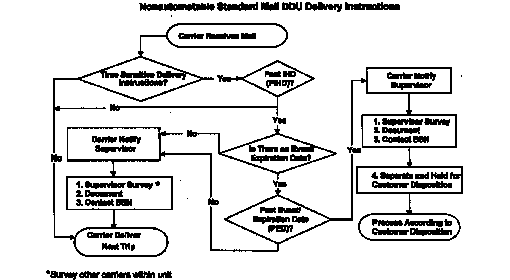
Currently, mailers may request that a mailing with an IHD, sale or event date, or an expiration date be withdrawn and
disposed of if not delivered by a certain date by either of the following two options (found in DMM D030.2.2):
1. The mailer may attach a facing slip to each package of mail showing the company name, person to contact, telephone
number (if collect calls are accepted), and the date after which the mailer does not want the mail delivered. The mailer
also authorizes the withdrawal of, but not the disposal of, the mail.
2. The mailer sends a written request to the postmasters of destination offices, before depositing the mail, stating that
time-dated mail is to be received at their offices and describing the mail by size, color, weight, identifying markings,
number of pieces, class of mail, and type of postage payment. The mailer also authorizes the withdrawal and disposal
of time-dated mail if received after a specific date.
Now, the mailer may notify the postmaster and all appropriate employees by printing the requested delivery dates and last
delivery date of value.
Delivery Verbiage and Placement
Note: All options are to be placed adjacent to as well as above or below the address area in a minimum of 8-point type.
Option One

Option Two

Option Three

- Delivery,
Delivery and Retail, 9-4-03
REVISED FORMS
The following six postage statements are revised to incorporate the additional data elements that must be completed by mailers entering mail with repositionable notes
attached:
• PS Form 3600-P, Postage Statement - First-Class
Mail - Postage Affixed
• PS Form 3600-R, Postage Statement - First-Class
Mail - Permit Imprint
• PS Form 3602-N, Postage Statement - Nonprofit
Standard Mail Letters and Flats - Permit Imprint
• PS Form 3602-NP, Postage Statement - Nonprofit
Standard Mail Letters and Flats - Postage Affixed
• PS Form 3602-P, Postage Statement - Standard
Mail Letters and Flats - Postage Affixed
• PS Form 3602-R, Postage Statement - Standard
Mail Letters and Flats - Permit Imprint
Copies of the six revised postage statements
appear on
pages 21-32 of this Postal Bulletin. A description of repositionable notes and the mailing standards for this service are
published in Domestic Mail Manual C810.7.0. That section
explains how to prepare repositionable notes and provides
information on mailpiece characteristics, mailpiece contents, mailpiece physical requirements and size standards,
notes characteristics, and compliance.
The revised postage statements are dated August 2003.
These revised postage statements include new entries for
data collection for repositionable notes. All mailers preparing and entering mailings with repositionable notes must
use the August 2003 statements (or approved facsimiles),
which contain these additions:
• Repositionable notes data collection box on page 1.
• Privacy Notice in the Certification section on page 1.
Mailers not preparing mailings with repositionable notes
may continue to use the June 2002 editions of PS Forms
3600-P, 3600-R, 3602-N, 3602-NP, 3602-P, and 3602-R until August 31, 2004. Mailers should, however, use the
August 2003 editions as soon as possible. Any edition before June 2002 is obsolete and cannot be used.
There will be no automatic distribution to Post OfficesTM
of printed copies of the August 2003 editions of the postage
statements. You can order these postage statements from
the Material Distribution Center as follows:
• Touch Tone Order Entry (TTOE): Call
800-332-0317, option 2.
Note: You must be registered to use TTOE. To register, call 800-332-0317, option 1, extension 2925, and
follow the prompts to leave a message. (Wait 48
hours after registering before placing your first order).
• E-mail: Complete PS Form 7380, MDC Supply Requisition (manually or using FormFlow), and send it as
an attachment to the e-mail address MDC, Customer
Service or to mcustome@usps.gov.
• Mail: Mail a completed PS Form 7380 to the MDC at
the following address:
SUPPLY REQUISITIONS
MATERIAL DISTRIBUTION CENTER
500 SW GARY ORMSBY DR
TOPEKA KS 66624-9702
PS Form 3600-P, Postage Statement - First-Class Mail - Postage Affixed
Use the following information to order PS Form 3600-P:
PSIN: PS3600-P
NSN: 7530-03-000-7026
Unit of Measure: EA
Minimum Order Quantity: 1
Bulk Pack Quantity: NA
Quick Pick Number: 186
Price: $0.0197
Edition Date: 08/03
PS Form 3600-R, Postage Statement - First-Class Mail - Permit Imprint
Use the following information to order PS Form 3600-R:
PSIN: PS3600-R
NSN: 7530-02-000-8049
Unit of Measure: SH
Minimum Order Quantity: 1
Bulk Pack Quantity: NA
Quick Pick Number: 187
Price: $0.0197
Edition Date: 08/03
PS Form 3602-N, Postage Statement - Nonprofit Standard Mail Letters and Flats - Permit Imprint
Use the following information to order PS Form 3602-N:
PSIN: PS3602-N
NSN: 7530-02-000-8047
Unit of Measure: SH
Minimum Order Quantity: 1
Bulk Pack Quantity: NA
Quick Pick Number: 191
Price: $0.0197
Edition Date: 08/03
PS Form 3602-NP, Postage Statement - Nonprofit
Standard Mail Letters and Flats - Postage Affixed
Use the following information to order PS Form
3602-NP:
PSIN: PS3602-NP
NSN: 7530-05-000-5031
Unit of Measure: EA
Minimum Order Quantity: 1
Bulk Pack Quantity: NA
Quick Pick Number: 192
Price: $0.0197
Edition Date: 08/03
PS Form 3602-P, Postage Statement - Standard Mail
Letters and Flats - Postage Affixed
Use the following information to order PS Form 3602-P:
PSIN: PS3602-P
NSN: 7510-05-000-4296
Unit of Measure: EA
Minimum Order Quantity: 1
Bulk Pack Quantity: NA
Quick Pick Number: 192
Price: $0.0197
Edition Date: 08/03
PS Form 3602-R, Postage Statement - Standard Mail
Letters and Flats - Permit Imprint
Use the following information to order PS Form 3602-R:
PSIN: PS3602-R
NSN: 7530-02-000-8053
Unit of Measure: EA
Minimum Order Quantity: 1
Bulk Pack Quantity: NA
Quick Pick Number: 194
Price: $0.0197
Edition Date: 08/03
The revised postage statements - along with all other
postage statements - are also available on the Postal ServiceTM Web site at www.usps.com; click Find a Form, then
All Online PDF Forms in Numeric Order. These forms can
be printed locally and completed manually. Wherever possible, postmasters and managers of business mail entry
should encourage their customers and staff to use the
Postal Service Web site to obtain the most up-to-date
forms.
Managers of business mail entry must ensure that all
Post Offices and detached mail units within the service
area of their district have access to all statements to meet
the needs of any local mailer who may want to enter mailings with repositionable notes. Post Offices without Internet
access must be supplied by their district office.
Mailers with questions about the use and availability of
postage statements should contact the Post Office where
they usually enter their mailings. Postal Service employees
with questions should contact their district manager of business mail entry.
- Mailing Standards,
Pricing and Classification, 9-4-03
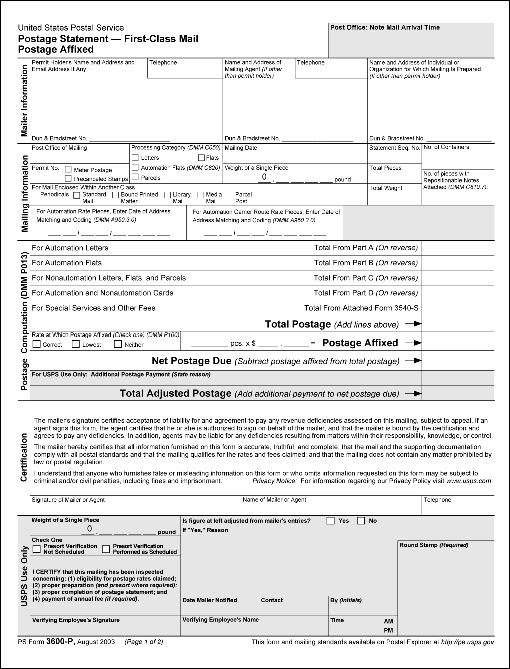


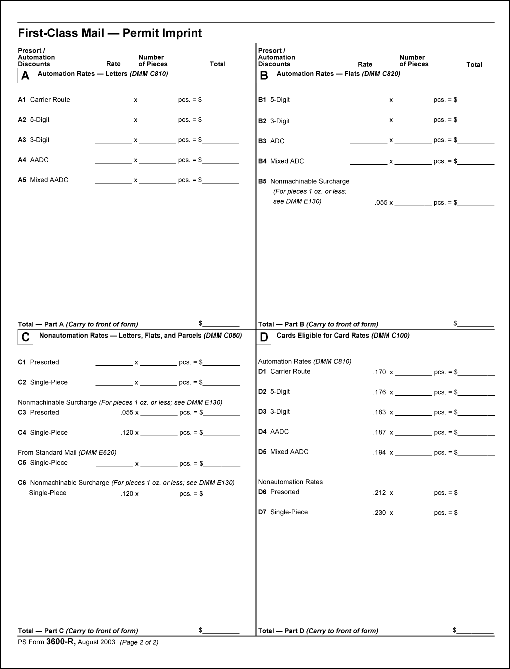

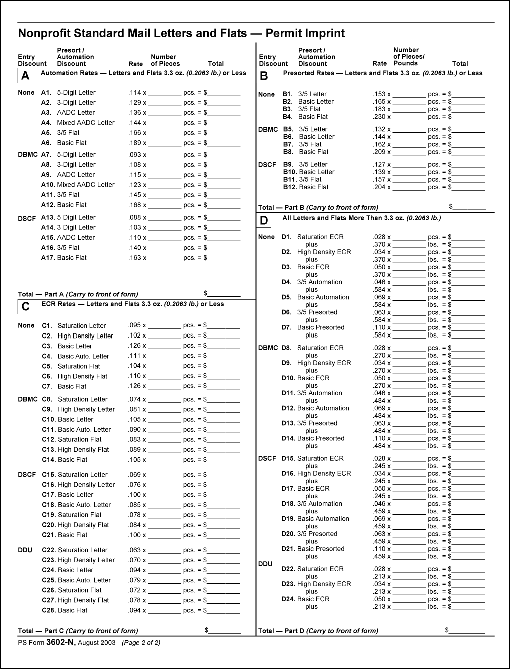
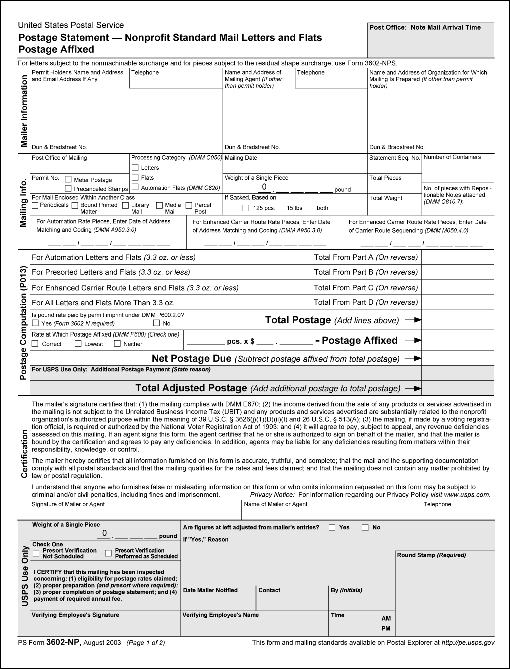
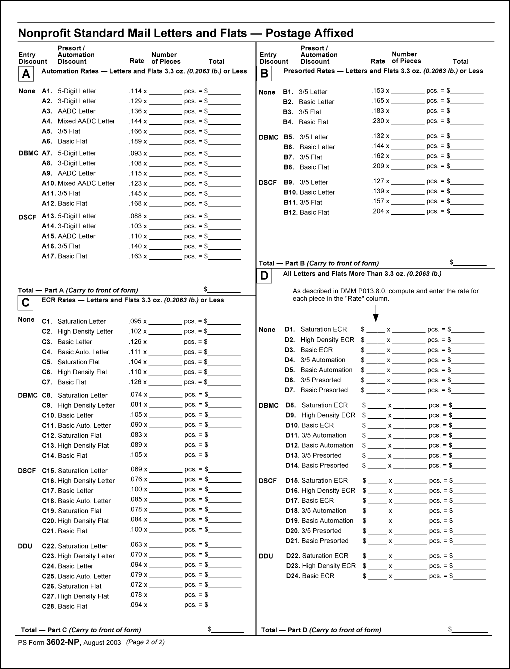
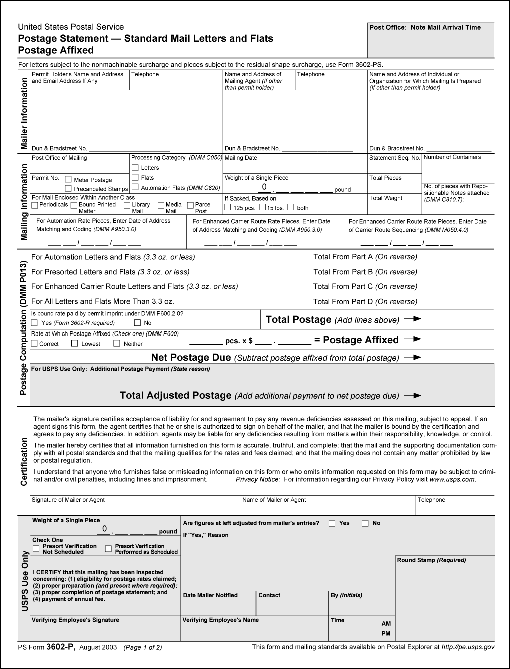
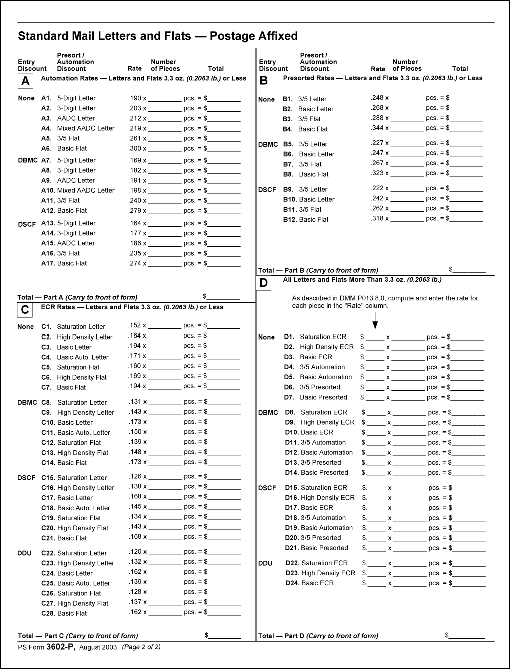
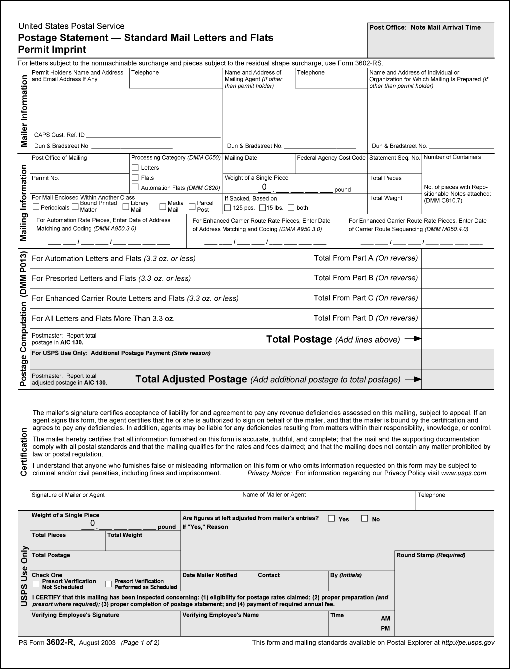
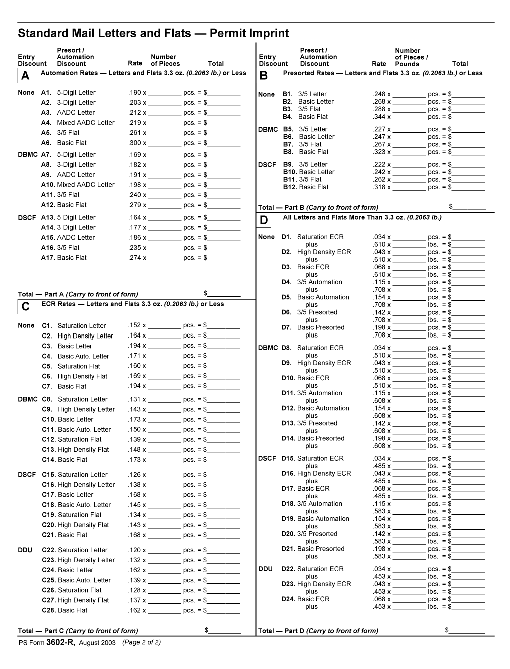
NEW POSTERS/CORRECTION
The article "New Posters: Posters 128 and 143 Show
Workplace Interaction Do's and Don'ts" in Postal Bulletin
22108 (8-7-03, pages 28-29) listed the incorrect NSN for
Poster 143. The correct NSN, and a new price, are shown
in this article in bold.
Diversity Development has published two posters
emphasizing the importance of addressing inappropriate
workplace behavior. Early identification and elimination of
inappropriate behavior helps to ensure that every employee in the United States Postal Service® can enjoy a
safe, secure, and productive work environment. Together,
these posters deliver a clear message that the Postal ServiceTM will not tolerate inappropriate behavior within the
organization.
Posters 128 and 143 are available on the Postal Service
PolicyNet Web site at http://blue.usps.gov/cpim; click on
Posters.
You can also order Posters 128 and 143 from the Material Distribution Center (MDC) as follows:
• Touch Tone Order Entry (TTOE): Call
800-332-0317, option 2.
Note: You
must be registered to use TTOE. To register, call 800-332-0317, option 1,
extension 2925,
and follow the prompts to leave a message. (Wait
48 hours after registering before you place your first
order).
• E-mail: Complete PS Form 7380, MDC Supply Requisition (manually or using FormFlow), and send it as
an attachment to the e-mail address MDC Customer
Service or to mcustome@usps.gov.
• Mail: Mail a completed PS Form 7380 to the MDC at
the following address:
SUPPLY REQUISITIONS
MATERIAL DISTRIBUTION CENTER
500 SW GARY ORMSBY DRIVE
TOPEKA KS 66624-9702
Both posters are described below.
Poster 128 comes in two sizes (i.e., 8 1/2-by-11-inch
and 16-by-20-inch posters).
The following information is needed to order Poster 128:
PSIN: POS128
NSN: 7610-05-000-5588
Unit of Measure: EA
Minimum Order Quantity: 1
Bulk Pack Quantity: 200
Quick Pick Number: N/A
Price: $0.0395
Edition Date: 12/02
Poster 143 shows a dialogue between a persistent person who gives unwanted attention and the recipient who
takes action and reports it to her supervisor.
The following information is needed to order Poster 143:
PSIN: POS143
NSN: 7690-05-000-5963
Unit of Measure: EA
Minimum Order Quantity: 1
Bulk Pack Quantity: 1,000
Quick Pick Number: N/A
Price: $0.3683
Edition Date: 02/03
- Headquarters and Field Programs,
Diversity Development, 9-4-03
HANDBOOK AND ELM REVISIONS
Effective September 4, 2003, Handbook F-15, Travel
and Relocation, and the Employee and Labor Relations
Manual (ELM) are revised to change the policy regarding
what payments a juror may keep when on court leave. The
payment to a juror for actual expenses, including mileage
reimbursement based on miles driven, is not considered a
court allowance.
We will incorporate these revisions into the next printed
edition of Handbook F-15 and the ELM and also into the
next update of the online versions accessible on the Postal
ServiceTM PolicyNet Web site at http://blue.usps.gov; click
on More References, then HBKs or Manuals, respectively.
Handbook F-15, Travel and Relocation
* * * * *
9 Handling Expenses for Special Travel
Situations
* * * * *
9-2 As a Juror
[Revise the introductory statement and item a in subchapter 9-2 to read as follows:]
If you are on court leave, follow these guidelines to determine what payments you may keep:
a. You may keep any allowances that you receive
for a daily rate of $25 or less. If the allowance exceeds $25 per day, you must remit the excess to your
supervisor.
* * * * *
Employee and Labor Relations Manual (ELM)
* * * * *
5 Employee Benefits
510 Leave
* * * * *
516 Absences for Court-Related Service
* * * * *
516.4 Fees
516.41 General
[Revise 516.41 to read as follows:]
Employees may retain any court allowance in the amount
of $25 or less per day on days court leave is authorized.
Employees must remit to their supervisor amounts received
in excess of $25 per day. Employees who are eligible to receive such fees are not authorized to waive the fee.
* * * * *
- National Accounting,
Finance, 9-4-03
HANDBOOK F-1 REVISION
Effective October 1, 2003, Fiscal Year 2004, the policy
and procedures for submitting the unit cash reserves authorization request to the district Finance manager for
amounts greater than 5 percent of the previous quarter's
average daily sales is revised. The current policy for the
cash portion of the individual stamp credits is unchanged.
Initially, the postmaster will determine
the amount needed to provide for normal cash flow operations. When a postmaster
or designee increases the amount in the unit cash reserve and/or the cash
portion of individual stamp credits
for current retained amounts, he or she must list the current
and the revised amounts on the attached Unit Cash Retained/Cash Reserves List
(see page 37). Justification will
be documented on the new Cash Retained/Cash Reserves
Notification Letter. These documents will be submitted to
the unit's district Finance manager for notification purposes
with a courtesy copy to the district Marketing manager. If
the district Finance manager finds the requested increase
outside the normal range of cash reserves, he or she can
deny the request and determine the appropriate cash reserve levels when necessary. The Internal Control Group's
routine analysis of cash retained can also trigger a review.
Each unit that has an existing unit cash reserve must
submit only the Unit Cash Retained/Cash Reserves List
showing all current cash reserve and cash portion of the individual stamp credits amounts. The unit then must submit
it to the district's manager of Internal Control.
After providing the initial list, send future lists and the
Cash Retained/Cash Reserves Notification Letter only
when there is an increase in AIC 753, Cash Retained.
For offices without a unit cash reserve, submit the Cash
Retained/Cash Reserves Notification Letter and the list
only when there is an increase in AIC 753, Cash Retained.
We will incorporate these revisions into the next printed
edition of Handbook F-1 and into the next update of the online version accessible on the Postal ServiceTM PolicyNet
Web site at http://blue.usps.gov/cpim; click on HBKs.
Handbook F-1, Post Office Accounting
Procedures
* * * * *
3 Managing Postal Funds
* * * * *
33 Funds Received
331 Cash Reserves
[Revise 331 to read as follows:]
The purpose for the procedure on cash retained in window
operations is to provide for normal cash flow operations
that meet the needs of the office. For the cash portion of the
individual stamp credits, retain $100 or 10 percent of the
accountability (whichever is less). In addition to the cash
portion of the existing stamp credits, units may also maintain a cash reserve to supplement these needs, if required.
To determine how much the office needs, calculate the previous quarter's postage sales and divide by the number of
business days to get an average daily sales amount. (If a
unit has reduced hours on Saturday, count those days as
1/2 days.) Multiply the average daily sales amount by 5 percent. Local management determines if this amount is sufficient. If the unit needs to increase the amount in the unit
cash reserve or in the cash portion of the individual stamp
credits from the amounts currently retained, then the unit
must do the following:
• Establish the unit cash reserve amount for the unit.
• Document any change from the
existing retained amounts for individual stamp credits and unit cash reserves
on the Unit Cash Retained/Cash Reserves
List (see Exhibit 331.1 on page 37) with justification
for the change on the Cash Retained/Cash Reserves
Notification Letter (see Exhibit 331.2 on page 38).
• Submit the letter and list to the district Finance manager for notification purposes, with a courtesy copy to
the district Marketing manager.
• Consign the additional amounts to a designated employee on PS Form 3369, Consigned Credit Report.
• File a copy of the letter with the PS Form 3369 for the
unit cash reserve.
• Implement the change and record additional reserves on PS Form 1412, Daily Financial Report, to
AIC 753 (Cash Retained).
• Reduce the cash reserves amount if the original
amount is denied by the district Finance manager.
Note: If the district Finance manager finds the requested
increase higher than the typical range of cash reserves relative to the location's office size and existing reserves, then
he or she can deny the request and determine the appropriate cash reserve levels, when necessary.
The district's Internal Control Group's routine analysis can
also trigger a review.
* * * * *
4 Managing Accountable Paper
* * * * *
42 Managing Accountable Paper at Stations,
Branches, and Post Offices With Stamp
Accountability
* * * * *
426 Handling Stamp Credits
* * * * *
426.4 Initiating a Stamp Credit - Cash
[Revise the title of 426.41 to read as follows:]
426.41 Sales and Services Associates
* * * * *
48 Managing Accountable Paper and Cash at
Offices With Segmented Inventory
Accountability
* * * * *
486 Cash Credits
* * * * *
486.1 Unit Cash Retained Reserve
[Revise item 1 of 486.1 to read as follows:]
1> The purpose of the procedure on cash retained in window operations is to provide for normal cash flow operations that meet the needs of the office. For the cash
portion of the individual stamp credits, retain $100. In
addition to the cash portion of the existing stamp credits, units may also maintain a cash reserve to supplement these needs, if required.
To determine how much the office needs, calculate the
previous quarter's postage sales and divide by the
number of business days to get an average daily sales
amount. (If a unit has reduced hours on Saturday,
count those days as 1/2 days.) Multiply the average
daily sales amount by 5 percent. Local management
determines if this amount is sufficient. If the unit needs
to increase the amount in the unit cash reserve from
the amounts currently retained, then the unit must do
the following:
• Establish the unit cash reserve amount for the
unit.
• Document any change from the
existing retained amounts for individual stamp credits and unit cash
reserves on the Unit Cash Retained/Cash Reserves List (see Exhibit 331.1 on page
37) with
justification for the change on the Cash Retained/Cash Reserves Notification
Letter (see Exhibit
331.2 on page 38).
• Submit the letter and list to the district Finance
manager for notification purposes, with a courtesy
copy to the district Marketing manager.
• Consign the additional amounts to a designated
employee on PS Form 3369, Consigned Credit
Report.
• File a copy of the letter with the PS Form 3369 for
the unit cash reserve.
• Implement the change and record additional reserves on PS Form 1412, Daily Financial Report,
to AIC 753 (Cash Retained).
• Reduce the cash reserves amount if the original
amount is denied by the district Finance manager.
Note: If the district Finance manager finds the requested
increase higher than the typical range of cash reserves relative to the location's office size and existing reserve, then
he or she can deny the request and determine the appropriate cash reserve levels, when necessary.
The district's Internal Control Group's routine analysis can
also trigger a review.
* * * * *
- Revenue and Field Accounting,
Finance, 9-4-03
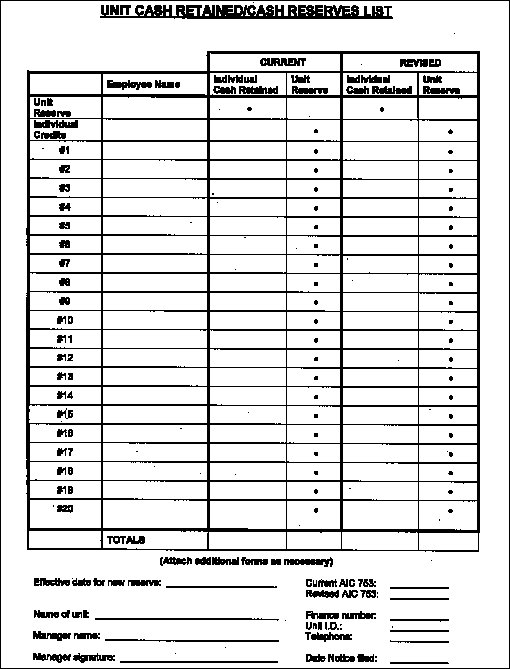
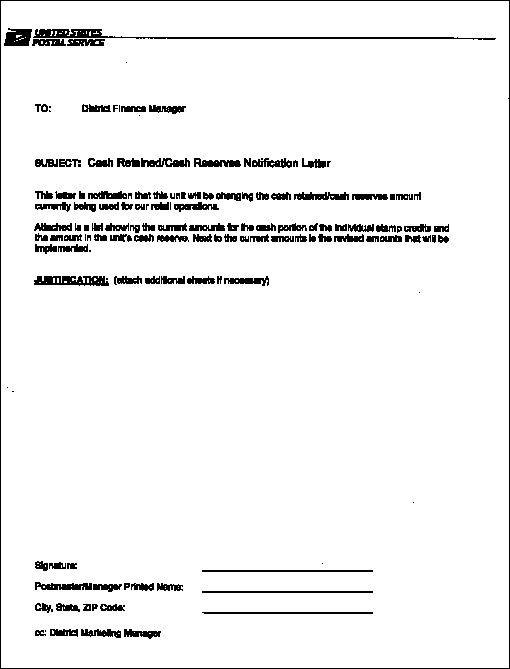
[D-LINK]
Finance Section continued
|

















